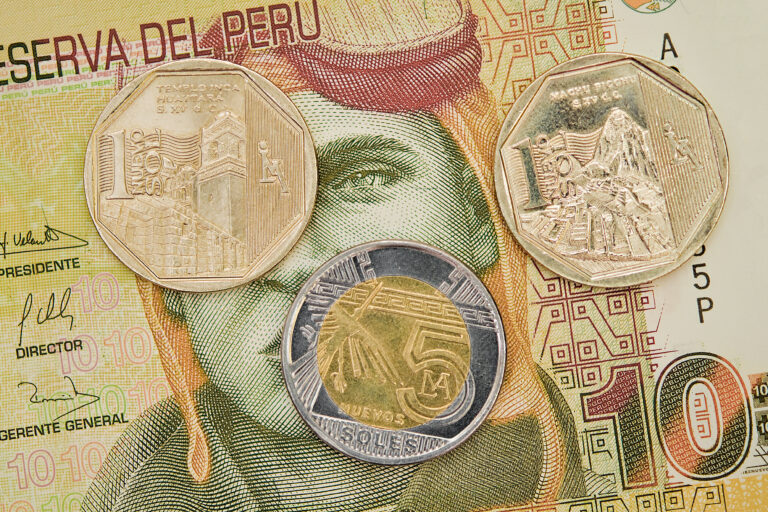Whether you’re planning a trip to the breathtaking Andes, exploring Cusco and Machu Picchu, or sending money to family and friends in Peru, understanding the nation’s currency is essential. The Peruvian sol has a long history that reflects the country’s vibrant culture and resilience.
This guide provides everything you need to know about the Peruvian sol, including its history, current denominations, exchange rates, and tips for handling money during your visit or transfer.
What Is the Official Currency of Peru?
The official currency of Peru is the Peruvian sol (S/.), which replaced previous unstable currencies in the 1990s. It is used throughout the country, from the historic streets of Lima to remote villages in the Amazon rainforest.
Here’s how it breaks down:
- Currency code: SOL
- Symbol: S/
When writing prices, the symbol precedes the amount. For example, S/550 indicates 550 soles.
Peru’s Currency Through Time
Peru’s monetary history reflects its colonial past and independence struggles, as well as its economic evolution. Before we explore the modern Peruvian sol, it’s helpful to understand its origins.
The Currency Before Independence
The city of Cusco was the hub of the Inca Empire, a dominant civilization in South America. Instead of coins or bills, the Incas used a sophisticated accounting system called quipu, which relied on knotted strings to track trade goods.
When Spanish colonists arrived in the 16th century, they introduced the Spanish real, which served as local currency for centuries. This system continued through Peru’s colonial period until independence in 1821.
Post-Independence Currency Struggles
Once freed from Spanish rule, Peru adopted its own version of the real in 1822. By the mid-20th century, the government introduced the Peruvian sol, meaning “sun,” reflecting Peru’s rich heritage.
However, the original sol was replaced by the inti in the 1980s due to high inflation. The inti was quickly overwhelmed by economic challenges, including hyperinflation.
The Birth of the Nuevo Sol
To stabilize the economy, President Alberto Fujimori implemented drastic measures in the 1990s. One key change was replacing the inti with the nuevo sol (new sun). This currency successfully controlled inflation and restored confidence in Peru’s financial system.
By 2015, the “nuevo” was dropped, and the currency is now simply called the Peruvian sol. Its robust design and secure features make it a strong symbol of modern Peru.
Current Peruvian Sol Banknotes and Coins
The Peruvian sol comes in both coins and banknotes, each showcasing unique elements of the nation’s history, culture, and identity.
Coins
The Central Reserve Bank of Peru produces coins in the following denominations:
- 10 centimos
- 20 centimos
- 50 centimos
- 1 sol
- 2 soles
- 5 soles
These coins are commonly used for small transactions across the country.
Banknotes
Peruvian sol banknotes boast detailed artwork and numerous security features to prevent counterfeiting. The denominations include:
- S/10
- S/20
- S/50
- S/100
- S/200
Each banknote celebrates a historical figure or cultural icon, reflecting Peru’s diverse heritage. For example:
- S/10 honors José Abelardo Quiñones, a national war hero.
- S/50 features Abraham Valdelomar, a prominent poet and journalist.
Security features like watermarks, raised ink, and microprinting ensure authenticity and protect the currency against fraud.
5 Fascinating Facts About the Peruvian Sol
1. The Name Honors Peru’s Heritage
The word “sol” translates to “sun” in Spanish, symbolizing brightness and renewal. The name reflects the country’s optimism during periods of economic reform.
2. It Saved an Economy in Crisis
During the late 1980s, Peru faced devastating hyperinflation, which devalued its currency. The introduction of the nuevo sol in 1991 shifted the nation toward economic stability and curbed inflation effectively.
3. Some Coins Are Phased Out
Low-value coins like 1 and 5 centimos were discontinued in recent years due to their declining relevance in everyday transactions.
4. Peruvian Bills Are Packed with Security Features
To combat counterfeiting, Peruvian sol banknotes include security features like three watermarks and color-changing ink. These details make them reliable and trustworthy symbols of commerce.
5. Credit Cards vs. Cash in Peru
While credit cards are widely accepted in Peru’s major cities, cash remains the preferred method of payment in rural areas. Always carry smaller banknotes to avoid issues breaking larger ones.
Understanding Peruvian Sol Exchange Rates
The value of the sol fluctuates due to economic and political factors. From global trade to national policies, numerous elements influence the sol’s relationship with major currencies like USD, EUR, and CAD.
Pro tip: Check real-time exchange rates on trusted transfer platforms like Remitly to secure the most favorable deal.
Tips for Obtaining Peruvian Soles
Visiting Peru or sending money? Follow these tips to safely obtain and use soles during your travels or transfers.
1. Avoid Airports for Currency Exchanges
Airport exchange counters usually charge higher fees. Consider smaller exchanges, located in hotels or casas de cambio (private exchange houses), for better rates.
2. Use ATMs
Withdrawing local currency from an ATM is often the easiest and most affordable solution. Many Peruvian ATMs accept Visa and Mastercard, and they’re widely available in cities.
3. Prepare Small Bills
Many businesses won’t accept large bills like S/100, given concerns about counterfeits. Carry smaller denominations to simplify transactions.
4. Protect Yourself from Counterfeits
Authentic soles have raised printing, security stripes, and crisp watermarks. Always inspect banknotes when receiving change and avoid damaged bills, as many businesses won’t accept them.
5. Exchange USD or EUR
Bring U.S. dollars or euros to exchange for soles. These currencies are widely traded in Peru, while others, like GBP or CAD, are less common.
FAQ About Peruvian Currency
What is the currency of Peru?
The official currency of Peru is the Peruvian sol (S/.), introduced in its modern form in 1991.
What denominations are available?
Coins are available in 10, 20, and 50 centimos as well as 1, 2, and 5 soles. Banknotes range from S/10 to S/200.
Will U.S. dollars work in Peru?
Some airports, hotels, and tourist areas accept U.S. dollars. However, it’s best to exchange them for soles for use in local markets and smaller towns.
Does Peru still use the “nuevo sol”?
No. The currency transitioned from “nuevo sol” to simply “sol” in 2015.
What is the current exchange rate?
Exchange rates vary daily. For real-time updates, check online converters or platforms like Remitly.

